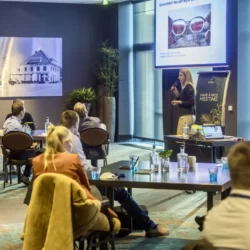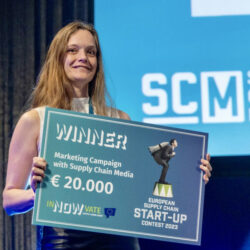Gartner conference provides ‘driving lessons’ for supply chain transformation

What do visitors stand to gain from attending the impressive Gartner Supply Chain Symposium in Barcelona? Martijn Lofvers spent three days at the modern conference centre, attended plenary keynotes and several breakout sessions, and talked to various supply chain executives, consultants and software vendors. Here, he looks back on this year’s event, at which – for him – the theme of ‘transformation’ was the common thread.
By Martijn Lofvers
I have been attending the European Gartner Supply Chain Symposium every year since 2013, apart from two COVID years. This year, the conference is being held for the second consecutive time at the brand-new conference centre in Barcelona. The unpredictable and changeable weather this time seems typical of the economic situation in which most companies find themselves.
Wearing a slightly damp suit, I walk through the main reception hall on Monday 10 June after registration. Despite the crowds, I soon meet a familiar business associate and we make our way together to the main hall for the plenary opening of the conference. Staff use small lightsabers to direct the audience forward into the sleek hall with lots of blue lights and the message ‘Shape the future’ on large screens. Loud, rousing pop music gets visitors in the mood: ‘Are you ready? Are you ready?’
From coasting to drive
Tom Enright (pictured), VP Analyst at Gartner, opens the conference in a role as a supply chain executive reading an email to his team. The company needs to focus on costs and cut budgets because executives believe that disruptions in supply chains are now over. ‘Viewing supply chains as a cost is totally wrong,’ says analyst Enright. ‘For many supply chain professionals, cost control feels like a straitjacket. Hence, after strenuous years, much fatigue prevails in supply chain.’
Enright says that after years when supply chains have been coasting, it is time to shift into the new mode of ‘Drive’. A picture of parched soil appears on the screen from which a fresh green plant is growing. Enright lists the four steps to get into this new state of control: contribute to multiple values, create opportunities in the face of uncertainties, remove complexity through designed simplicity, and unlock the value of employees through artificial intelligence (AI).
Know where and when to pursue different types of value, advises Enright. A segment of the business focused on low costs will produce a different distribution of value than segments with a focus on sustainability or innovation. ‘Learn to say “no” more often, if the commercial demand does not fit the stated focus.’ Using a seemingly simple diagram, he explains that strategy is not a simple choice between decentralization and centralization, but that in a matrix with ‘integrated’ and ‘differentiated’ along the axes, four different supply chains can be designed.
In themselves, these segmentation recommendations are right, but not particularly innovative. I myself published a Strategy Compass back in 2016 and applied it in internal workshops at several well-known companies in subsequent years. Determine the right business strategy of Product Leadership, Operational Excellence or Customer Intimacy by identifying what customers regard as the order winners for product groups, and link one of the six supply chain archetypes to this.
Seizing on uncertainty
According to Enright, the second step towards getting into Drive mode is to create opportunities in the face of uncertainty. Last year, Gartner launched the term ‘anti-fragile’ for this approach. At the time, I had to look up online exactly what that meant. Gartner explained at the time that antifragile systems turn stress and adversity into advantages, like the immune system does in the human body. Personally, I thought more of a child at play who learns through trial and error.
On the screen, Ulyana Fitsa, Chief Supply Chain Officer of animal feed producer Kormotech in Ukraine, explains in a simple video that her company has switched to local suppliers because of the ongoing war. She has achieved shorter delivery times and also lower costs as a result. My neighbour spontaneously starts talking about a video during the inNOWvate Supply Chain Event that impressed him more; that of CEO Olena Vdovychenko of Metro Ukraine and how they digitalized their stores there in the space of a year.
Removing complexity through designed simplicity is the third step Enright mentions. The VP Analyst says his own research shows that as many as 90% of companies are either in the midst of or on the verge of a transformation process. Many supply chain transformations he sees fail, or at least fail to deliver the expected benefits. ‘Make business processes and changes easy to understand and implement,’ says Enright. That, in my opinion, is precisely where the difficulty lies. While such comments about (failing) supply chain transformations raise questions in my mind, at the same time they provide me with an idea of what might become the central theme during the rest of the conference.
Application of AI
The fourth and final step, according to Enright, is to unlock the potential of employees by using AI. Thankfully, using a typical Gartner diagram, he explains the difference between traditional AI, which is used for forecasting and optimization, and generative AI, which automatically generates texts, images and videos. For both forms of AI, it is essential to build a clear and attractive business case. ‘Of all AI projects, only 54% make it from pilot to actual application in production. It’s like tossing a coin.’
He cites Amara’s Law, which states that we overestimate new technology in the short term and actually underestimate it for the long term. ‘Who would have expected in 2007, when the iPhone was introduced, that we would use our mobile phones for so many things nowadays?’ he says. Enright concludes his taut presentation with a hopeful statement that the future is yet to be written. ‘Therefore, move to a place where your business has not been before.’ As I leave the room, I reflect that Enright has captured the zeitgeist very well and mentioned the ‘why’ of the necessary steps. However, in his further explanation, he has only discussed the steps to be taken (the ‘what’) but hasn’t really said how.
Glocal
On the exhibition floor, featuring numerous stands from well-known software vendors as well as some consulting firms and logistics service providers, I bump into a supply chain director I know from a fast-growing international manufacturing company. Is his company also currently going through a transformation? ‘Yes,’ is the answer, ‘at our company, the transformation is called Project Octopus. This is because the brain is central in an octopus, but the creature’s eight tentacles are highly sensitive and flexible.’
The trigger for the transformation was a comment from the board that the supply chain was holding the company back due to the many acquisitions, a long tail of slow-moving products, high inventories and complex processes. ‘We started with a comprehensive blueprint of the intended supply chain processes. But when we went into the first country for implementation, we saw that this was not going to work. We have not abandoned the programme, but remain very practical and take into account the local culture. Perhaps this is the approach that was once called glocal: both global and local.’
In a subsequent presentation, Andrés Vadillo González, Head of Supply Chain Planning at pharmaceutical manufacturer Roche, says that the company is also in the process of transformation. According to him, the supply chain operating model has to change in an increasingly fragmented market worldwide. ‘You cannot achieve this without talents who understand modern, necessary technology,’ notes Vadillo González.
Storytelling
On day two of the conference, which is once again very rainy, Matthew Luhn of Pixar Studios opens with a very entertaining and inspiring presentation: ‘My job is to make people cry, but also make them laugh.’ As he talks about the secrets of successful animated films such as Toy Story, Ratatouille and Up!, I think – as a film lover – that I should dedicate a separate article to his presentation; there’s too much valuable information to summarize here. ‘A good story is the glue to make information stick,’ Luhn explains. ‘And all good stories are about transformations.’ More confirmation of the common thread I’ve spotted!
Sandeep Desai, Supply Chain Executive at Unilever, also comments in a breakout presentation that the ice cream division is facing a transformation due to the announced divestment. Fortunately, the company that sells one Magnum ice cream every second has already come a long way. But there is still a lot to be saved by optimizing its global supply chain network, creating end-to-end visibility and making its product portfolio less complex.
Another supply chain executive I know – from a different multinational – who I run into during a break tells me that her company is also in the process of transformation. ‘Actually, we are only now setting up the supply chains properly. We can sell all the organic ingredients we produce. But we need real-time visibility of our inbound and outbound ocean freight. Each week that our products spend longer in transit because we have to detour because of the Red Sea blockade negatively impacts our sales.’
Deaf and blind
The third and final day begins with an impressive presentation by Haben Girma, who is both deaf and blind. Together with her guide dog, she comes on stage and tells her story about the difficulties she had in getting a job. With a lot of perseverance, she managed to graduate in law from Harvard. She came up with all kinds of alternative strategies to still be able to keep up in society. After writing a bestseller on the subject, she even had a personal meeting with President Obama at the White House, using a Braille keyboard.
‘For innovation, we need to use our other senses,’ Girma says. ‘And we all depend on each other and all need help from others.’ In the room, an assistant relays the responses from the audience to her. Girma expects generative AI to change and improve a lot of things for people. I personally expect that, for disabled people, the automatic translation of text to speech and vice versa will lead to a lot of improvements.
After three intense days of numerous presentations and talks, I take stock. Outside, the sun finally breaks through. I ask one supply chain executive how this conference benefits him. ‘Gartner is like a driving instructor. During the usual half-hour calls with an analyst, you get pointers on how other companies have successfully implemented transformations. But during driving lessons, you have to drive yourself – just like in business.’
He tells me that because of the divestment of his consumer products division, he has had as many as 150 hours of calls. In a flash, my own varied driving experiences – including in a Formula 3 racing car and during a skid control course – shoot through my mind. You have to have been through many different transformations to recognize the right ones and know what to do, when and – above all – what not to do. For me, that is the most important insight from this year’s Gartner conference.










